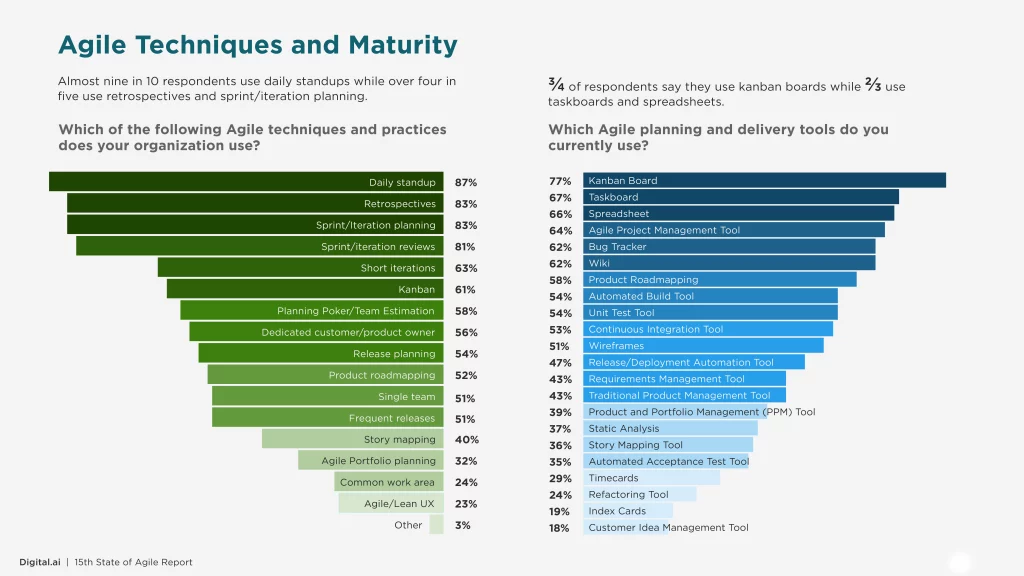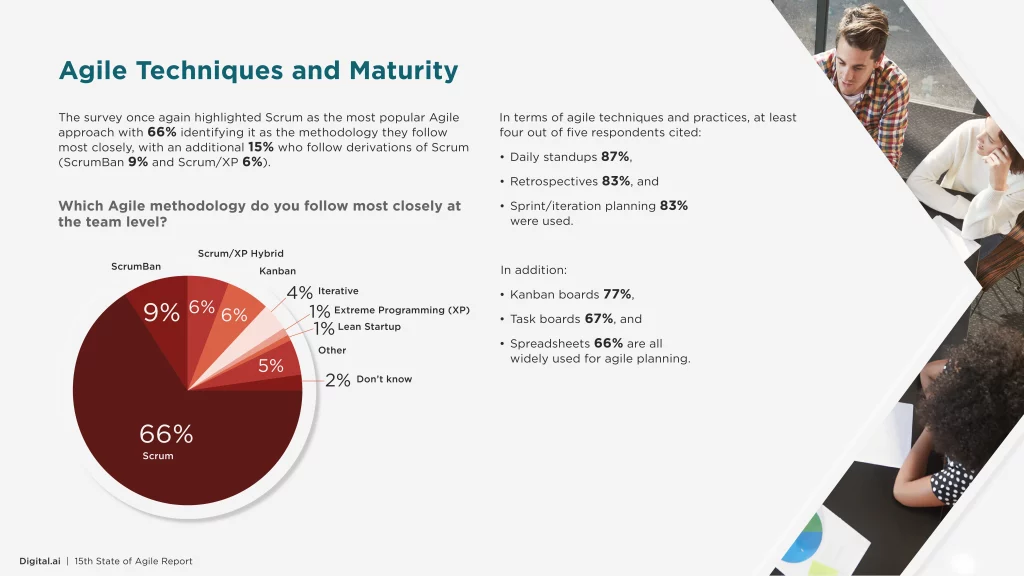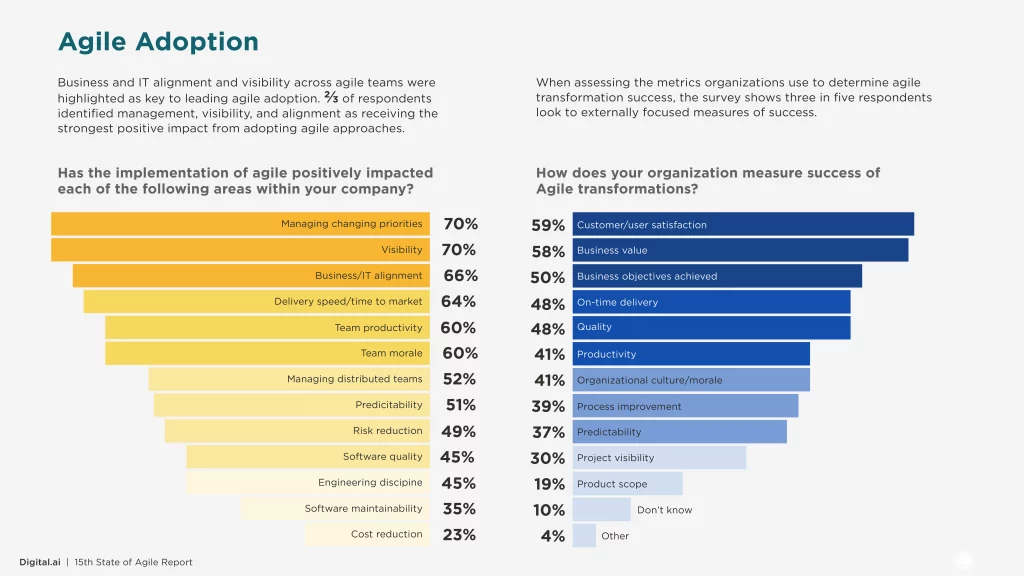Agile project management

What are agile methods?
The project management methodologies known as agile methods all have one thing in common: they are directly inspired by the Agile Manifesto published in 2001 by software developers determined to improve their processes and reduce their failure rate.
From there, various methods were progressively born, united by a new way of approaching product development by placing the customer at the heart of the action and by advocating the adaptation of creation processes as the project evolves. They have since become the standard in the field of application development.
What are the main principles of agile methods?
An agile methodology, whatever it is, foresees the splitting of the software development stages. Contrary to the traditional method which foresees the total planning of the project before its development, the Agile Manifesto advocates rather the setting of short-term objectives.
The project is thus fragmented into several sub-parts that the team in charge of it has to reach progressively, readjusting if necessary the objectives to meet the customer’s expectations as much as possible. Agile methods make it a point of honor to strengthen the relationships between the members of the project team, but also between the team and the client. This is why flexibility and agility in the organization are two fundamental pillars of agile methods.
What are the main agile methods?
Scrum and Safe are the most widely used agile methods. According to the VersioOne benchmark dated 2019, Scrum has a 54% market share in single-team agility, and Safe 30% in multi-team agility. In single-team management, Scrum is challenged by Kanban. While Scrum is adapted to the management of a single project, Kanban is better suited to the management of several projects or to TMA (third-party application maintenance) and MCO (maintenance in operational condition).
Combining the two approaches, Scrumban is suitable for more complex configurations. For example: the case of a team invested in the migration of an application to the cloud, but which will have to maintain the old versions of the software at the same time during the project. “The Scrumban board combines a Scrum timeline to manage the sprints of a project and a matrix of Kanban cards to supervise the resolution of bugs,” says Denis Delwail, agile coach of the agility practice within the French ESN Umanis, which has published a benchmark on agile methods.
Another single-team management method, Extreme programming (XP) pushes agile best practices to the extreme: refactoring, test-driven development, collective ownership of code… With XP, there are no sprints. The customer or the functional manager is always available to the developer. He must answer his questions within the hour.

What are the agile methods for scaling up?
Whether it’s Scrum, Kanban, Scrumban or XP, these approaches quickly reach their limit beyond a team of 5 to 9 people. To scale up to a larger number of developers, other methods, such as Safe, are recommended. “Safe introduces the notions of program and portfolio. The aim is to synchronize the work of several teams, each focused on a software component, with a view to aligning them with a coherent product policy,” explains Umanis.
With less than 1% of the market share, “Less and Nexus are no less relevant”, adds Denis Delwail. Both inspired by Scrum, these two methods use its main concepts. “Teams that have mastered Scrum can quickly adopt them in order to be integrated into a larger organization,” says the consultant. Both Less and Nexus are adapted to the management of “3 to 9 teams maximum”.

Agile project management: how to get started?
In order to obtain satisfactory results quickly, it is important to choose the methodology that best suits the development team’s flexibility needs. The members of the team must be involved in this implementation, as it often represents a real paradigm shift. It is necessary to move from a cascade or V-cycle project management to a much more flexible and scalable “product” management.
Agility also implies the implementation of some very specific rituals such as daily meetings, retrospectives or development cycle planning meetings. A time dedicated to learning and informing about the methodology is therefore essential.
How to bring Agile project management?
If you think Agile is right for you, here are 6 steps to follow for a successful implementation:
- Learn the Agile process and concepts. Take the time to discover the Agile methodology, its frameworks, principles and key concepts. Then, train your team, your customers and all the stakeholders who will be involved in your projects.
- Identify the projects on which you should not use this method. With each new project, it is a good idea to compare the advantages and disadvantages of Agile project management and determine if this approach meets your needs. This method is not always suitable and using it on the wrong project could have disastrous consequences.
- Break down any barriers. Make sure everyone has the same level of information, focus on team cohesion and encourage collaboration, make sure you use the right software and tools for Agile project management.
- Gain management support. Even the best Agile project management tools won’t work if management isn’t on the same page. They must support Agile principles and encourage the creation of an Agile environment.
- Start small. As with any evolution, it is essential to start with a small project. After an initial success, you can roll out the method to more teams and larger projects in the company.
- Monitor and adjust. After your first Agile project, if something didn’t work, it may be time to try another Agile framework or make other adjustments.
The Agile method is meant to be iterative, so it can be brought in the same way. Start small, focus on actions that can be done over short periods of time, evaluate what works and what doesn’t, be open to improvements, collaborate and communicate frequently, and make changes if necessary.









One Comment